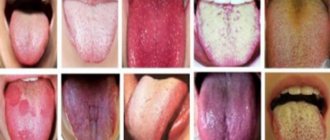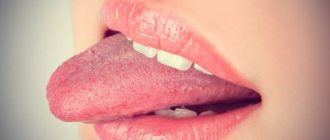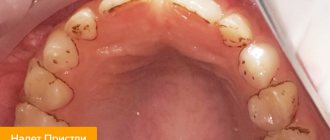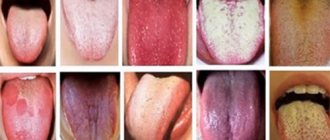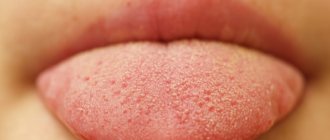.
For parents, children and their health are the most important thing. Every mother begins to panic when she sees the sad state of the child, the pale appearance of the face, the color of the tongue is different than before. The baby's tongue is very sensitive to the external environment. Its mucous membrane always reacts to taste factors, allergies, antibacteriosis and other phenomena. From this it can acquire a plaque. Based on its color, the doctor diagnoses possible diseases. Where does a child’s brown tongue come from and how can it threaten a child’s health?
Brown tongue in children may be a sign of a serious illness
What is plaque on the tissues of the tongue?
We will divide the reasons for the formation of layering into groups:
- anatomical;
- hygienic:
- medicinal.
The tongue as an anatomical organ of a person is unique in that its mucous membrane is covered with an epithelial cover with formations in the form of papillae. They help us taste food. They are also easily susceptible to the destructive effects of microbes and bacteria. Therefore, epithelial cells become obsolete, peel off, replacing themselves with young cells. But it happens that this process is inhibited by the upper layers of the epithelial membrane, which, during the active change of cells, die, but do not crumble, forming a coating on the tongue.
The cause of plaque is the use of strong antibiotics
Types of plaque
A similar phenomenon happens to everyone: both children and adults. We don’t even think about healthy plaque and don’t pay attention to it. It appears more or less depending on the time of year. In the summer, when the period of berries, fruits, and vegetables begins, the layer on the tongue is quite noticeable, since it has different shades:
- white;
- yellow;
- green;
- even dark blue.
In winter, plaque is not visible on a healthy body.
Yellow coating on the tongue occurs due to liver diseases
How to clear plaque from your tongue
To get rid of the problem, you need to regularly clean your tongue and understand what chronic disease leads to its appearance. If the masses do not occur often, but only from time to time, they are not dense, white or yellowish in color, regular oral hygiene is sufficient.
- Brush not only your teeth, but also your tongue. To clean its surface, you can use a special brush or the ribbed side of a regular toothbrush. Regular toothbrushes are not suitable for oral hygiene in children, as they are too hard. To do this, you can use special “finger” brushes with silicone bristles or regular gauze, which you can wrap around your finger and gently clean the baby’s tongue.
- Watch your diet. Include a sufficient amount of solid food, which contributes to the mechanical cleansing of surfaces in the oral cavity. Avoid products with active dyes.
- Rinse your mouth after every meal. This will remove “extra” particles and prevent them from accumulating between the taste buds.
- Do not smoke. A bad habit always causes characteristic changes in the oral cavity.
- Monitor symptoms of chronic illnesses. And consult a doctor promptly if they occur.
If everyday hygiene does not help get rid of plaque on the tongue, visit a general practitioner. You should not ignore the signals about violations that the body gives. Timely diagnosis helps to cope with any disease easier and faster, preventing its transition to a chronic form.
Why does plaque appear on the tissues of the tongue?
The appearance of dense plaque is often a symptom of a disease in the body. As soon as you notice that your tongue has become coated with a layer of distinctive color, you should be careful.
Thick plaque will indicate chronic diseases and complex infections.
Therefore, it is important to identify the cause of its formation in time. Especially when it comes to the health of the child.
Medical terminology
In medical practice, the following types of plaque stains are distinguished:
- diffuse,
- local.
A diffuse appearance occurs when the entire surface of the tongue is covered with a colored layer. The local type involves the formation of plaque on a specific area of the mucous membrane.
Diffuse plaque covers the entire tongue
In addition, the accumulation can have a different structure: be wet or dry, have a curd-like shape. Soft plaque can be quickly removed by scraping off with a toothbrush or a special scraper. A hard scraper is more dangerous and requires medical intervention.
How does plaque appear on a child’s tongue?
A brown coating on a child’s tongue occurs due to insufficient oral hygiene. It seems that infants cannot have such a problem, because they have no teeth and nothing to brush, but they also need to clean their mouth after breastfeeding. Kids learn to explore the world, so they taste everything, in this way they introduce different microorganisms to themselves.
Medications also provoke the appearance of a bacterial layer.
A newborn in the outside world is not protected from diseases and infections. In especially difficult cases, mothers have to turn to medicinal treatments. As a result, the child may develop an allergy to drugs, pathogenic microflora in the mouth, which reveals itself with a coated tongue.
What color should the tongue normally be?
Keep in mind! Such an unremarkable organ as the tongue performs a number of important functions:
- Articulation is responsible for the ability to pronounce sounds.
- Eating food - chewing, moving a bolus of food around the mouth, swallowing.
- Recognition of tastes - the sensation of sour, salty, sweet and bitter.
- Regulation of local immunity with the help of the tonsil in the mucous tissue of the root of the tongue.
Light, whitish deposits on the lingual surface are a type of normal .
You should know! They are a layer of keratinized epithelium (dead tissue from thread-like taste buds).
The tongue of a healthy child from 3 to 7 years old should meet the following characteristics:
- Color and structure . The surface is pink, soft, with a smooth groove in the center and visible tubercles of taste buds.
- Raid . A small amount of whitish plaque on the back is acceptable. It can be easily and painlessly removed with a toothbrush or cotton pad.
- Feel . The organ does not hurt, has no swelling or irregularities, and does not interfere with articulation and swallowing.
- Smell . Normally, there is no bad breath.
Important! To avoid possible problems with the oral cavity, teach your child to also clean the tongue surface while brushing his teeth.
This can be done either with a regular toothbrush or with a special scraper spoon.
Causes of brown plaque
Most often, a newborn's tongue becomes white or yellow. In the first case, it acquires color due to the formation of thrush, but quickly renews and passes. In the second case, the baby may have problems with the liver, which results in jaundice.
Brown plaque is less common and seems to be a more dangerous phenomenon for the child’s health, especially if it appears on the tongue of an infant.
Brown plaque in teenagers is due to hormonal changes
Doctors name the following reasons for a brown tongue:
- Disturbance of gastrointestinal processes, digestive problems.
- A state of dehydration resulting from elevated temperature or low fluid levels in the body.
- Lack of B vitamins.
- Ingestion of fats, food poisoning.
- Reaction to certain medications.
Coca-Cola turns your tongue brown
There is another reason that is not related to the biological nature of the body. This reason is somewhat banal, but it is not uncommon - eating brown foods:
- chocolate;
- caramels;
- soda;
- dark berries, etc.
A change in the appearance of the tongue occurs during the reaction of dyes with the mucous membrane. After all, parents are not always able to control their children’s consumption of foods with dyes. Buckwheat porridge can also leave a dark tint.
Why it appears: reasons
The reasons for the formation of brown deposits on the surface of this organ in a child are in many ways similar to the reasons for its appearance in an adult.
However, there are a couple of exceptions due to bad habits.
In adults, the coating on the tongue may become darker due to the abuse of caffeine and cigarettes, which is natural - not applicable to the baby.
In most cases, the coloring of this sensory organ in shades from red to brown is associated with disorders of the gastrointestinal tract.
Note! At the same time, the intensity of the color is directly proportional to the complexity and severity of the disease.
Other reasons include : _
- Diseases of the respiratory system (lungs, bronchi). Deposits appear in the morning after waking up, and after cleaning the oral cavity they appear again.
- Treatment with dyes or antibiotics. On some medicines (Faringosept, Malavit, etc.), the manufacturer himself indicates the likelihood of the appearance of colored plaque as the norm. As a rule, at the end of therapy, the tongue surface acquires its usual, healthy appearance.
- Food poisoning, dysbacteriosis . In this case, the formations are accompanied by a bitter taste, diarrhea or constipation, as well as pain in the lower abdomen. The unhealthy color will disappear only after the underlying disease is eliminated.
- Fungal infection of the mucous membrane (tissue microsis). The disease is characterized by thickening and then darkening of the natural plaque. Without proper treatment, the color will become more and more saturated.
- Dehydration of the body. Most often it is a consequence of disorders of the gastrointestinal tract. To solve the problem, you need to consult with a pediatrician on the selection of medications and provide the body with sufficient fluid.
Stay up to date! Sometimes a brown coating on the tongue may appear due to the consumption of chocolate, cocoa, Coca-Cola and other coloring products.
Shades of brown plaque
Due to problems with the digestion of the body, the tongue can acquire a brown color of different shades: light brown, yellow-brown and dark brown. When diagnosing a child, the doctor asks to show the tongue and by the shade he can find out the type of disease and its cause.
Layer light brown
A light brown color of the tongue will indicate a problem with the respiratory tract or lymph inflammation.
Digestive problems are the cause of yellow-brown plaque
Layer yellow-brown
The causes of yellow-brown plaque are more related to diseases of the stomach and intestines. The main reasons include:
- Inflammatory processes of the duodenum.
- Cases of bile entering the gastric tract.
- Cases of hepatitis.
- Prolonged dehydration due to vomiting or diarrhea.
A dark brown layer on the epithelium of the mucous membrane indicates that the child may have problems with the kidneys, liver, and gall bladder.
Tooth decay in children can cause plaque on the tongue
If you notice the appearance of a layer of brown plaque in any shade on your baby’s tongue, it is better to immediately consult a doctor.
Plaque for the little ones
A brown coating on a baby's tongue is a cause of concern, as this is not typical for him. The first and main reason for this phenomenon will be the introduction of complementary foods into food, when the mother’s milk is no longer sufficient. Taking complementary foods is not an easy process for a newborn’s body. He still can't get used to the new nutrients. Brown plaque is the baby’s body’s reaction to supplements.
A newborn's coated tongue may indicate bowel problems and even a lung problem.
But in such cases, mothers should pay attention to the child’s temperature. If a child has a fever and at the same time there is a brown coating on the tongue, it is necessary to call an ambulance in order to provide qualified assistance in a timely manner.
A yellow coating appears in infants with the start of complementary feeding
Examination of a child in the clinic
Self-medication by parents can end in failure. For proper consultation, you should contact your pediatrician, who will determine the cause and method of preventing infection.
It is important to consider the location of plaque on the tongue in newborns. If the accumulation is visible at the tip, this may indicate a problem with the functioning of the lungs, and may be a sign of bronchial disease. If the layering does not disappear within 2-3 days, this may be a manifestation of an infectious disease such as scarlet fever or influenza. In the form of symmetrical spots, it is a symptom of incipient pneumonia. A brown layer in the center of the tongue is a clear sign of a gastrointestinal disease. In the specialized literature, the concept of “geographical” language is found - this is when plaque spots are localized along the surface in different parts. This kind of coating may indicate infection of the baby’s body with worms.
A consultation with a dentist will help identify the cause of the plaque.
Diagnosis of the disease
In a hospital examination, an accurate diagnosis is established after a general and biochemical blood test, an antibody test, a scraping from the mucous membrane of the tongue, and a urine and stool test. Other studies may be needed: ultrasound of the stomach and intestines, respiratory tract, fiberoscopy and gastroscopy, etc.
Chocolate stained tongue
Depending on the detected test results, parents should consult a doctor: gastroenterologist, toxicologist, infectious disease specialist. If a child’s baby teeth begin to erupt or are already clearly visible, then you should definitely show them to the dentist; sometimes the reason is that the baby has carious teeth.
Localization and taste sensations
It is believed that specific diseases can be diagnosed by the location of curdled or colored masses. But, according to Ilya Antonov, localization does not at all indicate any disturbances in the body. But it only speaks of the uneven distribution of layers. Whereas taste sensations are more informative.
- Bitterness in the mouth indicates a disruption of the pancreas.
- A sour taste occurs due to various malfunctions in the gastrointestinal tract, in which acids from the stomach are thrown into the oral cavity. But it can also be present with regular and abundant consumption of sweet foods. Oddly enough, but after sweets the mouth usually becomes “sour”.
- Dryness in the mouth indicates a malfunction of the salivary glands or a banal failure to comply with the drinking regime.
If you have any doubts, it’s better to ask a doctor what the coating on your tongue means. In these cases, Ilya Antonov recommends contacting a therapist, since usually the diseases indicated by the appearance of plaque are associated with chronic disorders in the body.
pixabay.com/
Prevention of brown plaque on the tongue
We have already found out the reasons for the appearance of a brown coating on a child’s tongue. But how can you prevent this symptom? Rules should be followed to prevent all kinds of diseases associated with changes in the color structure of the tongue. These rules are stated by doctors all over the world, and they are also often voiced by the famous doctor Komarovsky. The rules are simple, but must be followed systematically:
- The room where there is a child must always be clean and tidy; the room should be ventilated, the air humidified.
- At the first appearance of a brown plaque, the mother should call a doctor rather than try to cure the symptom on her own (whether using medication or grandma’s folk remedies).
Oral hygiene - prevention of plaque formation
You need to constantly monitor your baby's condition. If you notice a plaque, think about what the child has been given to eat recently, what he has taken, how he is doing with the toilet, and whether he has a fever. If you notice a connection with foods, try reducing the dose for a couple of days or completely removing it from your diet. Then check to see if the natural color of the tongue has returned. The main thing is to establish in time the tendency towards darkening and thickening of the plaque layer.
If your child already indulges in sweets, limit the amount of colored foods: candy, marmalade, soda. All this food has a destructive effect on the child’s body, including the epithelium of the tongue.
Attention to color
According to Ilya Antonov, the color of the plaque is important and is taken into account by the doctor when examining the patient and diagnosing diseases. But even if the shade looks unusual, this does not mean that you need to sound the alarm.
“As a rule, a white or yellow coating on the tongue does not indicate anything serious,” comments the doctor. “But a large amount of it is a sure sign of disruption of the gastrointestinal tract.”
Green and red, although they look scary, usually only indicate that a person included “coloring” foods in his diet. And the colored pigments were absorbed by the porous mass on the surface of the tongue.
A brown coating on the tongue may appear if you love coffee or frequently drink strong black tea. But if there is reason to suspect metabolic diseases or problems with the gastrointestinal tract, the doctor takes plaque into account as one of the symptoms of diabetes mellitus or liver disease.
pixabay.com/
In babies of the first year of life, the tongue rarely has a “normal” pink hue. In most cases, it is white, but this does not indicate illness at all, but rather the characteristics of the diet. Babies are fed only breast milk or formula for up to six months, and then receive soft, pureed food. This consistency does not allow food to mechanically clean the surface of the tongue. In addition, the milk or formula itself leaves a sour milk film in the child’s mouth.
“Plaque on the tongue of a newborn does not mean anything if the child is healthy,” says dentist Ilya Antonov. “You only need to worry if there are signs of illness, such as fever.”
Temperature causes disruption of metabolic processes in the body, changes in the composition of saliva and excessive layering of particles on the tongue surface. But only a doctor can understand which organ failed or what caused the disease. Self-diagnosis without appropriate experience and qualifications will not be informative.
How to treat brown plaque?
It is difficult to talk about the treatment of brown plaque, since it is not a separate disease, but only a symptom. No doctor will recommend any medications or procedures to cure a coated tongue. It is not the symptom that needs to be treated, but the disease.
The main diseases that manifest themselves with similar indicators include:
- Gastritis.
- Stomach ulcer.
- Infection.
- Weakened immunity.
- Oral diseases.
Only a specialist doctor can make a correct diagnosis and prescribe appropriate treatment. It will identify high-quality antibiotics. It happens that he prescribes a topical medication such as tretinoin. After the course of treatment, the appearance of brown color on the tongue will disappear.
The drug Tretionin is prescribed by a doctor for treatment
Features of consistency and thickness of plaque
In order not to lose sight of the onset of any serious disease, it is necessary to regularly examine the baby’s oral cavity.
At the same time, you should pay attention not only to the presence of plaque, but also to its consistency, location and thickness .
Your observations will make the pediatrician’s work easier in making a diagnosis.
As a result of many years of medical observations, it was possible to establish the following relationship between plaque on the tongue and the condition of the human body:
- A thin/spotty coating on the tip of the tongue indicates diseases of the heart muscle and respiratory system.
- A thick layer of brown deposits on the root indicates intestinal pathologies.
- A brown stripe in the center of the tongue can be a “signal for help” from the spleen, gall bladder or liver.
Important! Do not try to make a diagnosis and prescribe treatment yourself - this can be dangerous for the baby’s health. Only a doctor can determine the true root cause of the disease.

